How does a diode work?
Placed onHave you ever wondered how the devices around you work so smartly and efficiently? The secret lies in small parts that play a vital role in the operation of all our favorite gadgets. One of these incredible building blocks is the diode. In this article we are going to explore the fascinating world of diodes, how they work and why they are so important. Get ready for an exciting journey into the world of electronics, where diodes control the current and bring our devices to life!
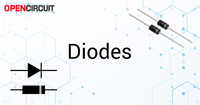
What is a Diode?
A diode is a small electronic component that allows electric current to pass in one direction and block it in the opposite direction. Imagine a diode as a one-way street, where cars (electric current) are only allowed to travel in one direction.
 A diode allows current to flow in one direction
A diode allows current to flow in one direction Diodes are the silent superheroes of electronics. They may be small, but they play a vital role in the operation of all kinds of devices we use every day, from smartphones and laptops to microwave ovens and televisions. They have the power to decide which way the electric current goes, which is why they are so important.
These small but strong components help our devices operate safely by protecting them from dangerous voltage spikes and ensuring a stable power supply. They are also experts at converting AC to DC power, which is important for charging our phone batteries and running many other devices.
The basis of diodes: semiconductor material
Diodes are made of special materials known as semiconductors. Silicon and germanium are the most common semiconductors. Semiconductors sometimes behave as a conductor (a material that conducts electricity well) and sometimes as an insulator (a material that does not conduct electricity). This unique property is what makes diodes so useful in electronic circuits.
A diode consists of two different types of semiconductor material: P-type and N-type. P-type material has positively charged particles (holes) and N-type material has negatively charged particles (electrons). When these two materials come together, they form a PN junction.
 PN junction
PN junction When a positive voltage is applied to the P side of the diode and a negative voltage to the N side, the electrons and holes are drawn to the PN junction, allowing the electric current to flow through the diode. This is called "forward bias".
If the voltages are reversed, the electrons and holes are pushed away from the PN junction, creating a barrier that blocks the flow of current. This is called "reverse bias".
This unique ability to conduct current in one direction and block it in the opposite direction is what makes diodes so valuable in electronic circuits. It enables them to play a vital role in numerous applications such as rectifiers, voltage regulators, signal sensing and much more.
The history of diodes: From the first discoveries to modern innovations
The history of diodes begins with the discovery of the first form of a diode, the so-called radio diode or 'crystal detector', in the early 20th century. These primitive diodes were used in early wireless communication devices, such as crystal receivers, to detect radio signals. They consisted of a piece of semiconductor crystal, usually galena, and a thin metal wire or "cat scratcher" pressed onto the crystal surface.
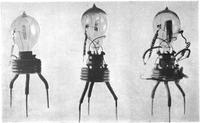 Fleming valves
Fleming valves The first true semiconductor diode was developed in the 1940s with the invention of the point contact diode, which consisted of a thin wire in contact with a semiconductor material such as silicon or germanium. However, these diodes were limited in their applications due to their low reliability and limited current capacity.
In the 1950s, the modern diode, the so-called 'junction diode', was introduced. These diodes are made of semiconductor materials such as silicon or germanium, with a clear distinction between the P- and N-type semiconductor layers. Junction diodes provided a huge improvement in reliability and performance compared to their predecessors.
Since then, numerous types of diodes have been developed for different applications, including light-emitting diodes (LEDs), Zener diodes, Schottky diodes, and many other variants. Diodes have evolved from simple crystal detectors to sophisticated semiconductor components critical to modern electronics.
Applications and examples: Diodes in action
Diodes are finding their way into a wide variety of applications in our electronic world, and it's fascinating to see how they harness their powers to perform a variety of tasks. Here are some examples of how diodes come into action:
rectifiers: One of the most common applications of diodes is to convert alternating current (AC) to direct current (DC). This is crucial for charging batteries and powering many electronic devices that rely on stable DC power.
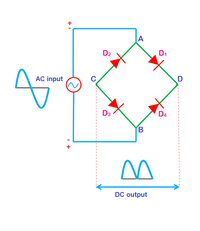 bridge rectifier
bridge rectifier Voltage regulators: Diodes help maintain a constant voltage in electronic circuits. They ensure that sensitive components are not damaged by voltage peaks and contribute to the reliability and longevity of our devices.
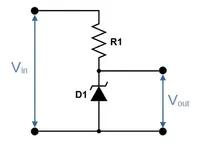 Zener diode as voltage regulator
Zener diode as voltage regulator Signaling and lighting: Light-emitting diodes (LEDs) are special diodes that emit light when current flows through them. They are widely used in energy-efficient lighting and as indicators on appliances to indicate operating status.
 light-emitting diodes
light-emitting diodes Solar panels: In solar energy systems, diodes ensure that the power generated by solar panels does not flow back to the panels when the sun is not shining. They thus increase the efficiency of solar energy systems.
 bypass diode
bypass diode Measure temperature: While not always the most accurate method, some diodes can be used as temperature sensors, measuring the change in voltage across the diode and converting it to a temperature value.
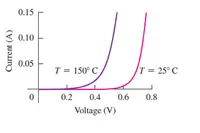 Diode as temperature sensor
Diode as temperature sensor Circuits with logic gates: Diodes are sometimes used to build simple logic gates in digital electronics, such as diode AND and diode OR gates.
 Diode AND & OR gate
Diode AND & OR gate The versatile world of diodes
In summary, diodes are essential components in electronic devices that affect our daily lives. From converting AC to DC, regulating voltage, to creating energy efficient lighting, diodes are all around us. These small, yet powerful components help improve the reliability and efficiency of technologies we use every day. Diodes will undoubtedly continue to innovate and contribute to the continuous development of the electronics industry.
- 50 pieces In stock Opencircuit 1N5817 20V 1A Scotty rectifier diode - 50 stuks € 3,-
- 50 pieces In stock Opencircuit 1N4007 1000V 1A Rectifier diode - 50 stuks € 2,15
- 50 pieces In stock Opencircuit 1N4006 800V 1A Rectifier diode - 50 stuks € 3,-
- 10 pieces In stock Opencircuit 1N5408 1000V 3A Rectifier diodes - 10 stuks € 2,25
- 50 pieces In stock Opencircuit 1N4004 400V 1A Rectifier diode - 50 stuks € 2,50
- 50 pieces In stock Opencircuit 1N4002 100V 1A Rectifier diode - 50 stuks € 2,30
- 50 pieces In stock Opencircuit 1N4001 50V 1A Rectifier diode - 50 stuks € 2,65
- 50 pieces In stock Opencircuit 1N60 50V 50mA Scotty barrier diodes - 50 stuks € 2,85
- 50 pieces Opencircuit 1N4003 200V 1A Rectifier diode - 50 stuks € 3,-
- 50 pieces Opencircuit 1N4148 75V 300mA Small signal diode - 50 stuks € 2,60
Has this article piqued your interest in diodes? Let yourself be inspired by our range of high-quality diodes, suitable for numerous applications! Click here to explore our collection and find the perfect diode for your next electronic project.










